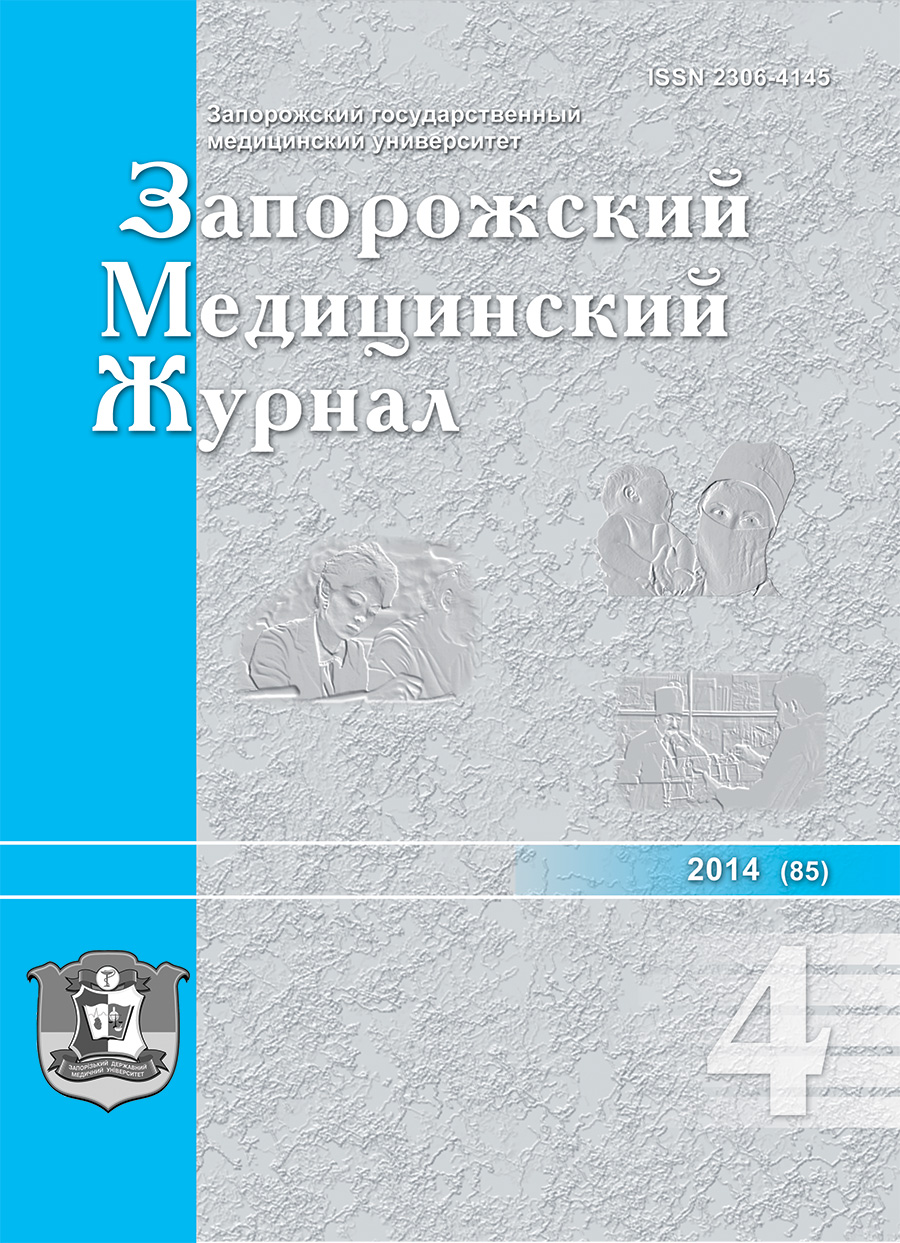Predictors of adverse postoperative course of cholecystectomy in mini-incision access and laparoscopic cholecystectomy
DOI:
https://doi.org/10.14739/2310-1210.2014.4.27221Keywords:
Cholelithiasis, Cholecystectomy, The Postoperative Period, Postoperative ComplicationsAbstract
Background. Shift from laparotomy to laparoscopy qualitatively changed surgery aggressiveness, allowed to reduce the number and severity of postoperative complications. New methods of minimally invasive interventions introduction have generated a number of legitimate questions relating to the desirability, safety, possible range of applications, the effectiveness of interventions. However, no studies in the literature devoted to the development of criteria for predicting the likely complications of surgical data and adverse postoperative course.
Aim of the study - to identify the most significant predictors of adverse postoperative course of the laparoscopic cholecystectomy and laparotomy cholecystectomy from the minimum access.
Material and methods. Retrospective study included 102 patients with cholelithiasis who routinely were performed cholecystectomy. Cholecystectomy from minimum laparotomy access was performed in 48 (47,1%) patients. 54 (52,9%) patients underwent laparoscopic cholecystectomy. The groups were comparable by age, sex, height, weight, body mass index.
Statistical processing of the material was carried out with software package Statistica 6.0. and MedCalc10.2.0.0. Parametric (t-test for dependent and independent variables, ANOVA ANOVA, paired Pearson correlation) and nonparametric (Wald-Wolfowitz runs test, Kolmogorov-Smirnov two-sample test, Mann-Whitney U test, correlation Spearman) statistic methods were used. Differences considered statistically significant at a value of p <0,05. Method for constructing operating characteristic curves (ROC-analysis) was used for the risk of adverse postoperative course assess. Predictors of adverse postoperative period were measured with Cox proportional hazard model. Independent indicators of adverse postoperative course were built with multivariable Cox proportional hazard model, the variables included reverse stepwise method.
Results. Positive prognostic value had the follow: initial ESR 20 mm / hr, total bilirubin of less than 18.2 mmol / L, ALT activity at least 64 conventional units, amylase less than 38 units , a diameter of choledoch 6.2 mm less than the common bile duct and the duration surgery less than 35 minutes. Negative predictor ability possess: baseline hemoglobin more than 131 g / l, leukocytosis more 11 109 / L, sizes gallbladder stones greater than 2 mm, more fibrinogen 4.44 g / l, increased direct bilirubin more than 12.7 mmol / l. Independent indicators of adverse postoperative course include: ESR greater than 20 mm / hour (specificity 75%, sensitivity 57.1%, p = 0.02) increases the risk of postoperative hyperthermia of 1.68 times (95% CI 2,2-74, 1); total bilirubin more than 18.2 mmol / l (specificity 79.2%, sensitivity 66.7%, p = 0.0002) increases the risk of postoperative hyperthermia of 1.14 times (95% CI 1,04-9,62). Stones in the gallbladder with a diameter greater than 2 mm (specificity 100%, sensitivity 53.8%, p = 0.001) increase the risk of postoperative hyperthermia 1.06 times (95% CI 1,03-8,42); type of intervention: minimum access laparotomy instead of laparoscopic cholecystectomy (specificity 76.9%, sensitivity 53.8%, p = 0.05) increases the risk of postoperative hyperthermia in 4.04 times (95% CI 2,02-74,12).
Conclusion. Results of the study allowed to identify predictors of favorable and unfavorable postoperative course in patients with cholelithiasis, allowing to reduce risk of postoperative complications of laparoscopic cholecystectomy as well as of minilaparotomy cholecystectomy access.
References
Galimov, O. V., Hanov, V. O., Fajzullin, T. R., & Ronzhin, A. E. (2012) Laparoskopicheskaya kholecist e`ktomiya po metodike «edinogo dostupa» s primeneniem ustrojstva dlya fiksacii zhelchnogo puzyrya [Laparoscopic cholecystectomy procedure "single access" using the device for fixing the gallbladder]. Klinicheskaya i e`ksperimental'naya khirurgiya. Retrieved from www.jecs.ru. [in Russian].
Kashtal'jan, M. A. (2009) Povrezhdenie zhelzhnogo puzyrya vo vremya laparoskopicheskoj kholeciste`ktomii [Damage to the gall bladder during laparoscopic cholecystectomy]. Klinichna khirurhia, 7–8. [in Ukrainian].
Zacks, S. L., Sandler, R. S., Rutledge, R., & Brown R. S. (2002) A population-based cohort study comparing laparoscopic cholecystectomy and open cholecystectomy. Am J Gastroenterol, 97, 334–340.
Borovikov, V. (2001) STATISTICA: iskusstvo analiza dannykh na komp'yutere. Dlya professionalov [STATISTICA: art computer data analysis. for professionals]. Saint Petersburg: Piter. [in Russian].
Phillips, M. S., Paraskeva, P., Roberts, K., Marks, J. M., Shah, S., Rubach, E., et al. (2012). Intermediate results of a prospective randomized controlled trial of traditional four-port laparoscopic cholecystectomy versus single-incision laparoscopic cholecystectomy. Surgical Endoscopy, 26(5), 1296-1303. doi: 10.1007/s00464-011-2028-z.
Downloads
How to Cite
Issue
Section
License
Authors who publish with this journal agree to the following terms:
Authors retain copyright and grant the journal right of first publication with the work simultaneously licensed under a Creative Commons Attribution License that allows others to share the work with an acknowledgement of the work's authorship and initial publication in this journal. 
Authors are able to enter into separate, additional contractual arrangements for the non-exclusive distribution of the journal's published version of the work (e.g., post it to an institutional repository or publish it in a book), with an acknowledgement of its initial publication in this journal.
Authors are permitted and encouraged to post their work online (e.g., in institutional repositories or on their website) prior to and during the submission process, as it can lead to productive exchanges, as well as earlier and greater citation of published work (See The Effect of Open Access)

